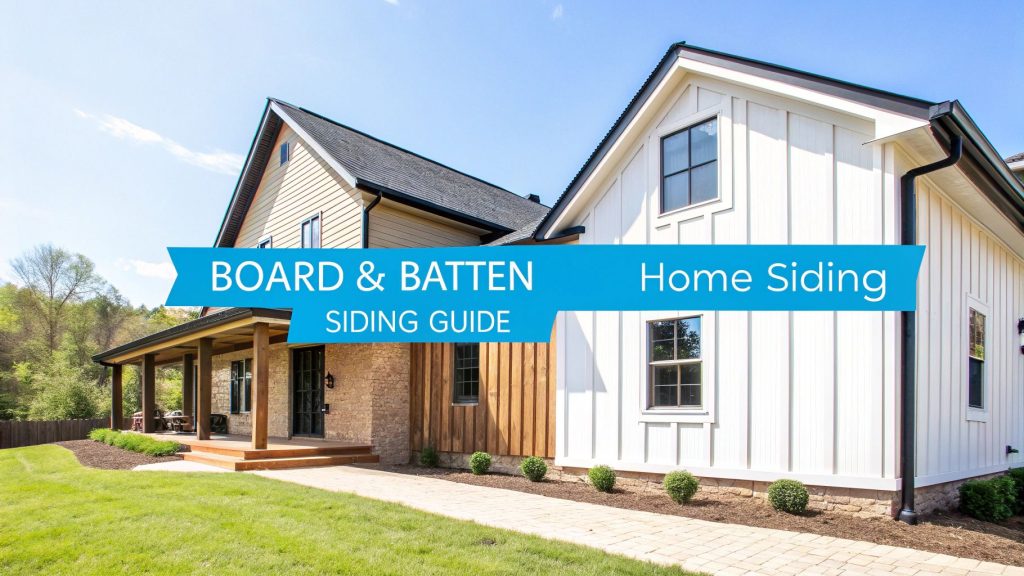Chances are you've seen board and batten siding, even if you didn't know its name. It’s a timeless style where wide vertical boards form the base, and the seams where they meet are covered by narrower vertical strips called battens. This clever, layered pattern creates a striking look full of clean, powerful lines, giving a home's exterior a sense of height and character, making it a popular choice for homeowners looking to elevate their curb appeal.
What Is Board and Batten Siding
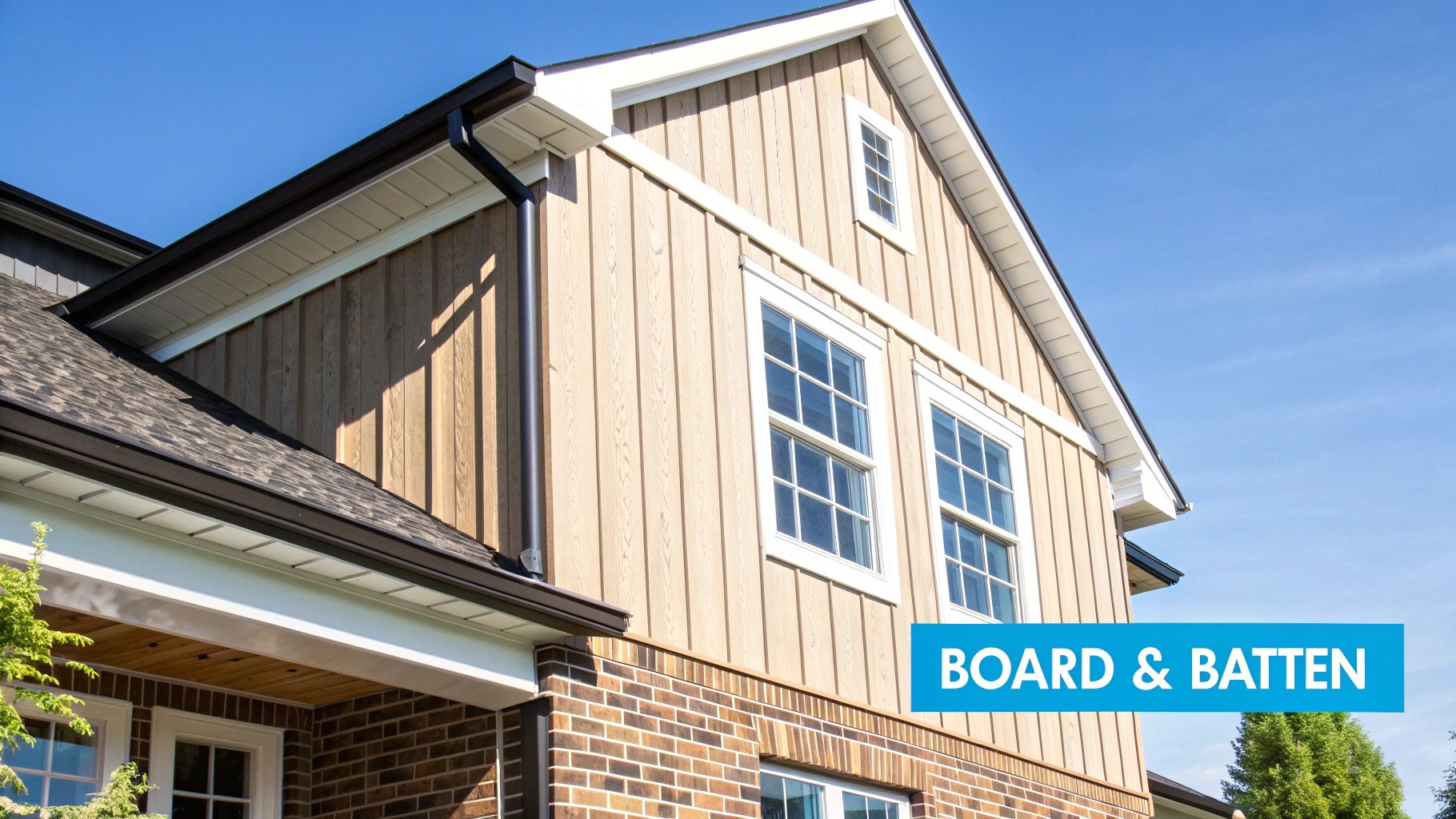
Think of it like building a classic wooden fence. You have your main vertical planks, but there are always tiny gaps between them. Board and batten takes that idea and perfects it for a home by placing a smaller strip—the batten—right over that gap. It's a simple concept, but it creates an incredibly effective, weather-tight seal.
But this isn't just a functional trick. It's a design powerhouse. The strong vertical lines naturally draw your eyes upward, making any house feel taller and a bit more grand. It’s a fantastic way to break away from the visual monotony of standard horizontal siding, adding rich texture and shadow lines that shift beautifully as the sun moves across the sky.
The Key Components
At its heart, the system is beautifully simple, though it demands real precision to get right during a siding replacement. Two main parts work in tandem to shield your home from the elements.
- Boards: These are the wide, foundational planks that go up first. Installed vertically against the home's exterior wall sheathing, they create the primary barrier against weather.
- Battens: These are the much narrower strips that are installed directly over the seams between the boards. Their entire job is to seal those gaps, locking out wind, rain, and anything else nature throws at your home.
This interlocking design is a proven method for creating a rock-solid exterior. When a professional installs it, they make sure there are zero exposed seams, which is a huge benefit for homeowners in consistently damp climates like we have here in the Pacific Northwest. The final product is a home that doesn't just look great but is also exceptionally well-protected.
A professional siding contractor will always account for the natural expansion and contraction of the materials, ensuring the battens are secured properly without causing the boards to warp or crack over time. This foresight is crucial for long-term durability, especially in regions with fluctuating temperatures.
To give you a clearer picture, here's a quick rundown of what makes this siding style such a popular choice for homeowners.
Board and Batten Siding at a Glance
| Feature | Description | Primary Benefit |
|---|---|---|
| Vertical Orientation | Boards and battens are installed up and down. | Creates the illusion of height and a modern look. |
| Layered Construction | Battens overlap the seams between boards. | Provides superior protection against moisture and wind. |
| Dimensional Texture | Creates distinct shadow lines and visual depth. | Adds significant curb appeal and architectural interest. |
As you can see, the combination of form and function makes it a compelling option for anyone looking to boost both their home's resilience and its style.
From Rustic Barns to Modern Homes
Board and batten siding has a fascinating story, one that stretches from the rugged farmsteads of old-world Europe all the way to the sleek, modern homes we see today. What began as a purely practical solution for farmers has blossomed into a sought-after architectural style, bringing a legacy of resilience and simple ingenuity to every home it graces.
Believe it or not, the story starts in Scandinavia. Builders in places like Norway and Sweden needed a straightforward, effective way to shield their buildings from the harsh, unforgiving weather. Their solution? A simple system of wide boards and narrow battens. By the mid-1800s, this clever method made its way to North America, becoming a popular and sturdier alternative to the traditional log cabin around the 1840s. You can dive deeper into the full history of board and batten siding.
This arrival was perfectly timed. Home construction was undergoing a massive shift with the invention of balloon framing, a technique that used long, continuous wooden studs to build taller, more graceful homes. The strong vertical lines of board and batten siding were the ideal match, accentuating this new height and giving homes a wonderfully stately look.
From Farmland to Fine Homes
At first, people called it "barn siding" for a good reason—it was everywhere on agricultural buildings where function trumped form. It was cheap, easy to put up, and the overlapping battens created a tight seal against wind and rain, which was absolutely crucial for protecting livestock and harvests.
But it didn't take long for architects to see its beauty. During the Gothic Revival movement of the mid-19th century, designers praised board and batten for its honesty and "strength and truthfulness." Those clean, unpretentious lines resonated with a growing desire for simpler, more authentic design.
This was the turning point. Board and batten was no longer just a practical choice; it became a deliberate design statement. It managed to blend rustic charm with an emerging sense of modern elegance, a duality that is the very reason it remains so popular today.
Why This Classic Style Endures
Knowing its history helps explain why board and batten siding feels both classic and completely current. It has the authentic feel of a time-tested building method, yet it fits perfectly with today’s most popular designs, from modern farmhouses to minimalist contemporary homes. When you choose this style, you’re not just picking a material—you're weaving a piece of architectural history into the very fabric of your home.
It's a true testament to great design: something born from necessity that became beautiful through its own simplicity. This rich background is what makes board and batten more than just a fleeting trend. It’s a lasting choice that delivers genuine character and proven performance.
Choosing Your Board and Batten Materials
When you picture board and batten siding, you probably think of classic, rustic wood. And for good reason—wood has a timeless charm. But today’s homeowners have a whole world of materials to explore, each with its own perks when it comes to performance, upkeep, and style for your siding replacement project. Picking the right one is especially important in demanding climates like ours in the Pacific Northwest.
While traditional wood is still a favorite, modern alternatives are really taking center stage. In fact, though about 15% of new homes in rural and suburban areas stick with wood board and batten, materials like vinyl, fiber cement, and engineered wood now account for over 60% of new installations in major markets. These newer options give you that classic look but with far better weather resistance and less maintenance. Vinyl and fiber cement alone make up roughly 45% of all board and batten installations in the U.S. residential market. You can learn more about the evolution of board and batten materials and how we got here.
This infographic breaks down key metrics like installation time, material costs, and what you can expect for annual maintenance with different siding options.
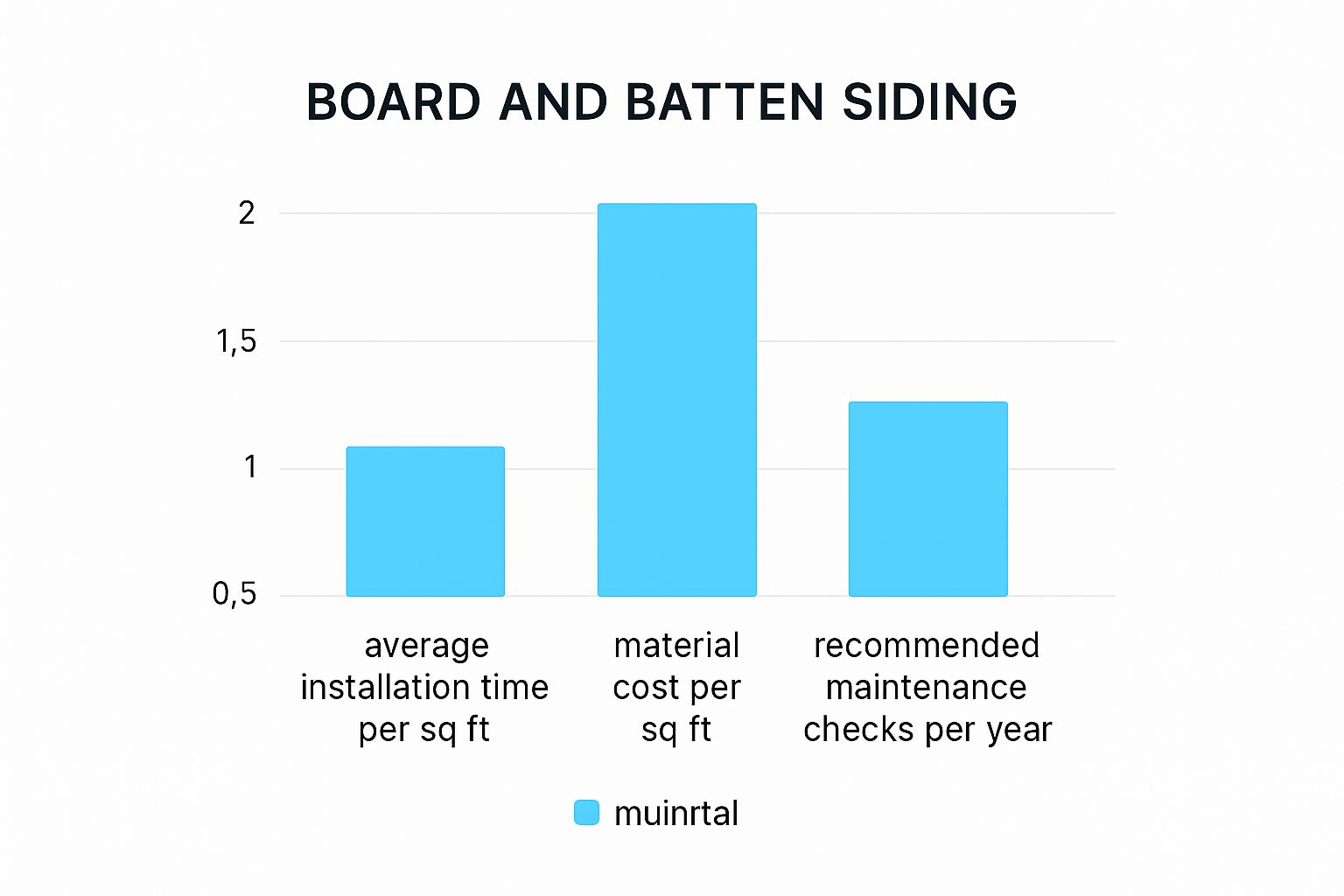
As you can see, the initial price tag is just one part of the equation. The real cost of ownership often comes down to the long-term commitment to maintenance.
Modern Material Options
As you're thinking about what board and batten siding is and if it's right for your home, you need to look past just the curb appeal and really consider durability and upkeep. Every material has its own strengths, so the best choice really boils down to your budget, personal style, and how much weekend work you're willing to put in.
To help you decide, let's break down the most popular choices side-by-side.
Comparison of Board and Batten Siding Materials
| Material | Average Cost (Per Sq. Ft.) | Durability | Maintenance Level | Best For |
|---|---|---|---|---|
| Natural Wood | $5 – $12 | Moderate | High | Homeowners seeking authentic, rustic charm who don't mind regular upkeep. |
| Vinyl | $4 – $8 | High | Very Low | Budget-conscious homeowners who want a classic look with minimal maintenance. |
| Fiber Cement | $6 – $15 | Very High | Low | Those wanting maximum durability, longevity, and resistance to fire and pests. |
| Engineered Wood | $5 – $10 | High | Low | A balance of wood's appearance with enhanced stability and weather resistance. |
This table gives you a snapshot, but let's dive a bit deeper into what makes each material unique.
- Natural Wood: Nothing beats the real thing for authenticity and warmth. Cedar is a fantastic choice because it naturally resists rot and insects. But—and it's a big but—it needs regular sealing, staining, or painting to protect it from moisture and prevent warping. It's a high-maintenance relationship.
- Vinyl: Think of vinyl as the cost-effective, low-maintenance workhorse. It won’t rot, warp, or attract pests, and you’ll never have to pick up a paintbrush. It's the perfect "set it and forget it" option for anyone who wants the board and batten look without the work.
- Fiber Cement: This is the heavyweight champion of durability. Fiber cement, particularly from a top-tier brand like James Hardie, can mimic wood grain beautifully while shrugging off fire, rot, moisture, and pests. It’s a smart investment if you're looking for maximum protection and peace of mind.
- Engineered Wood: A clever composite that blends wood fibers with resins, engineered wood gives you a more stable and often more affordable option than natural wood. It’s designed to have better resistance to moisture and insects right out of the box.
A crucial trade secret for any board and batten installation is to ensure a proper "rainscreen" gap is left between the siding and the house wrap. This small air channel is a game-changer; it lets any moisture that sneaks behind the siding drain away and allows the wall to dry out completely. This single step prevents catastrophic rot and is an absolute non-negotiable best practice for siding replacement in the Pacific Northwest.
Making the Right Choice for Your Climate
For homeowners in coastal areas or places that see a lot of rain like here in the Pacific Northwest, your choice of material is absolutely critical. Natural wood is gorgeous, but it's incredibly vulnerable to moisture-related problems if it isn't maintained perfectly.
That's why fiber cement is often the go-to professional recommendation for wet climates. It's completely inert to water—it simply won't swell, rot, or fall apart. Similarly, vinyl is an outstanding water-shedding material that holds up exceptionally well to constant dampness and even salt spray, making it another top contender for long-term performance in challenging environments.
The Real-World Benefits for Your Home
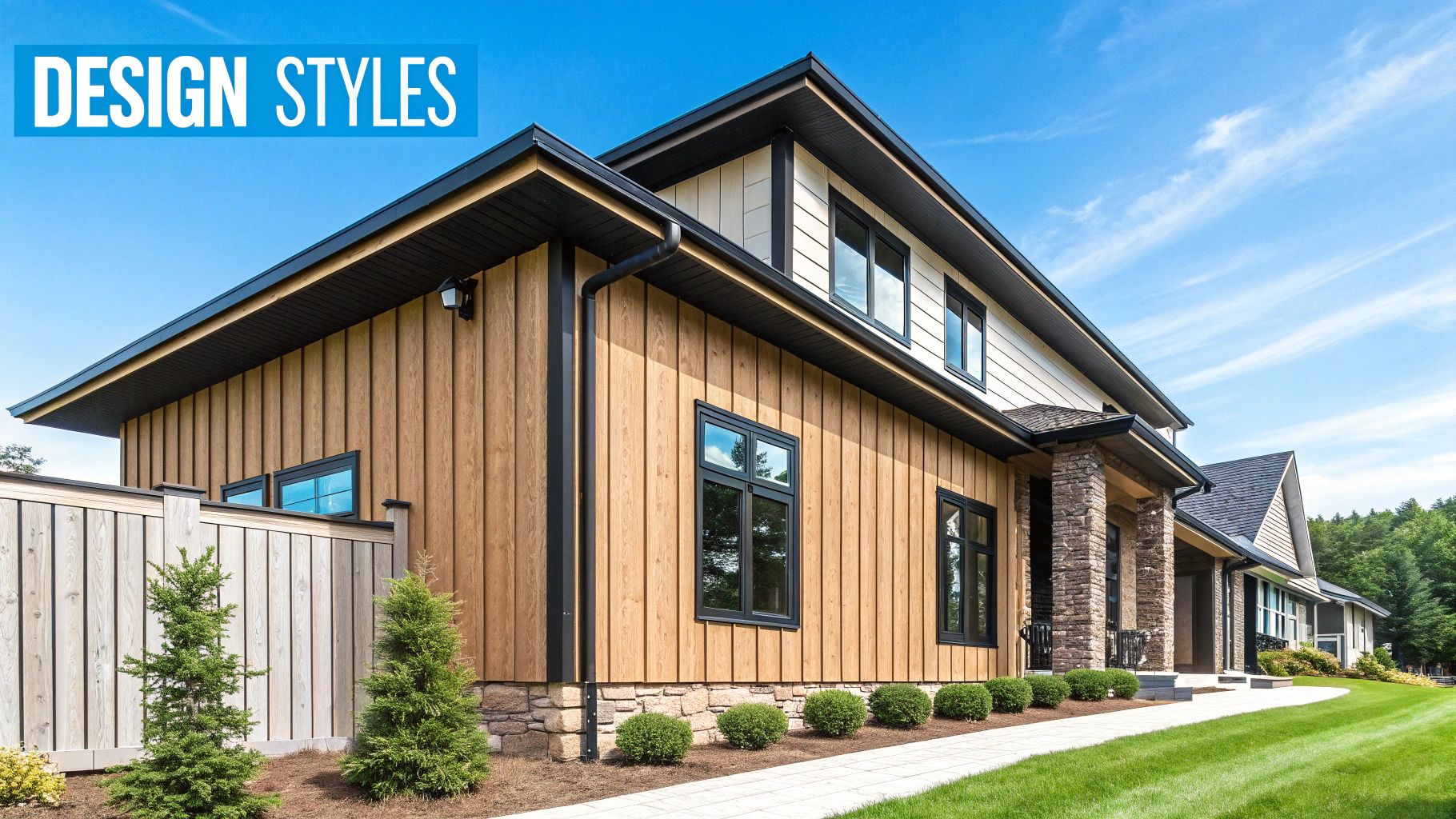
When people first ask about board and batten siding, it's almost always because they're captivated by its unique look. But that distinctive curb appeal is just the beginning. This siding style brings some serious, practical advantages to the table, making it a smart investment that goes far beyond just aesthetics.
The first thing you notice is how it changes a home's presence. Those clean, strong vertical lines have a way of drawing your eye upward, giving the entire structure a taller, more stately feel. It’s a classic architectural trick that can make a one-story home feel grander and a two-story home look even more impressive—an effect you just don't get with standard horizontal siding.
A Smarter Way to Protect Your Home
One of the biggest wins with board and batten is baked right into its design. The overlapping batten system isn't just for looks; it's an incredibly effective way to create a weather-tight seal for your home. By covering the seams between the wider boards, the battens form a layered barrier that does an amazing job of locking out wind and rain.
For homeowners, especially those in rainy climates like the Pacific Northwest, this is a huge deal. Think about it: horizontal siding has thousands of seams that can potentially trap water. Board and batten's vertical layout, on the other hand, gives water a direct path to run straight off the house. This dramatically lowers the risk of moisture getting trapped behind the siding, which helps prevent the kind of slow-moving rot that can lead to major headaches down the road.
For a siding replacement to be truly effective, every detail matters. A professional installer ensures the battens are perfectly sealed over the board joints, creating a continuous defense against moisture. This precision is what transforms a good-looking exterior into a high-performance protective shell for your home.
Better Efficiency and Long-Term Durability
That tight seal does more than just keep water out; it also helps with your home's energy efficiency. The overlapping design drastically reduces air gaps, which means fewer drafts and a more stable indoor temperature. That extra layer of insulation can make a noticeable difference in your heating and cooling bills.
In fact, some studies show a proper board and batten installation can improve a home’s insulation by up to 12% compared to traditional styles. While an estimated 70% of homeowners choose it for its timeless look, another 25% are won over by its superior durability and energy performance. You can find more details on these siding benefits on watsonmetals.com.
At the end of the day, going with board and batten pays you back in several ways. You get a home with standout curb appeal, tougher protection against the weather, and a little relief on your energy bills. It’s a complete upgrade that improves not just how your home looks, but how it functions for years to come.
Installation and Upkeep: The Pro's Guide
Great siding is more than just the material you choose; it's all about the installation. A proper job is what makes board and batten truly shine and stand the test of time, especially in a damp climate like the Pacific Northwest. It's a craft, and the details really matter.
Let's talk about one of the most common mistakes we see: incorrect board spacing. Wood and even some composites need room to breathe. They expand and contract with the weather, and a smart installer accounts for this by leaving a small, intentional gap between each vertical board, usually about a quarter-inch. This tiny space is crucial for preventing the siding from warping or buckling as the seasons change.
The battens come next, and their placement is everything. They’re not just for looks—their main job is to cover those expansion gaps, creating a weather-tight seal. If they aren't aligned perfectly and fastened securely, you're inviting problems.
Pro-Level Installation Practices
Getting that flawless, durable finish comes down to a few key techniques that seasoned pros swear by. These aren't shortcuts; they're the methods that protect your home from moisture and prevent those headaches down the road.
- The Right Fasteners are a Must: This might seem like a small detail, but it’s huge. We always use corrosion-resistant fasteners, like stainless steel or hot-dipped galvanized nails. Using the wrong kind can lead to ugly rust streaks bleeding down your beautiful new siding.
- A Rainscreen is Your Best Friend: Here’s a true sign of a quality job. A "rainscreen" system involves adding thin furring strips behind the siding. This creates a small air gap that allows any water that sneaks past the boards to drain away safely. It also promotes airflow, which is the key to keeping your wall dry and preventing rot.
We once worked on a home where a tiny, hidden leak had been spraying water inside the wall for years. The rot was extensive and only discovered by accident. A rainscreen would have given that moisture a path to escape, likely preventing thousands of dollars in damage. It’s a powerful lesson in why these details are so critical for siding replacement.
Keeping Your Siding Looking Great
Once your board and batten is up, a little bit of upkeep goes a long way in keeping it pristine for decades. The routine really just depends on the material you chose.
- For Wood Siding: Natural wood will always need the most love. Give it a once-over every year, looking for any cracking, peeling paint, or signs of pests. Depending on how much sun and rain it gets, you’ll likely need to re-seal or repaint it every 3-7 years.
- For Fiber Cement and Vinyl: This is where modern materials make life easy. For the most part, a simple wash-down once a year with a soft brush and some mild soap is all it takes to clear off any dirt or mildew. Just make sure to check the caulking around windows and trim every so often to keep those seals tight.
Following these simple steps ensures your siding doesn't just look good on day one—it continues to protect your home and keep its curb appeal for years to come.
Creative Ways to Style Board and Batten
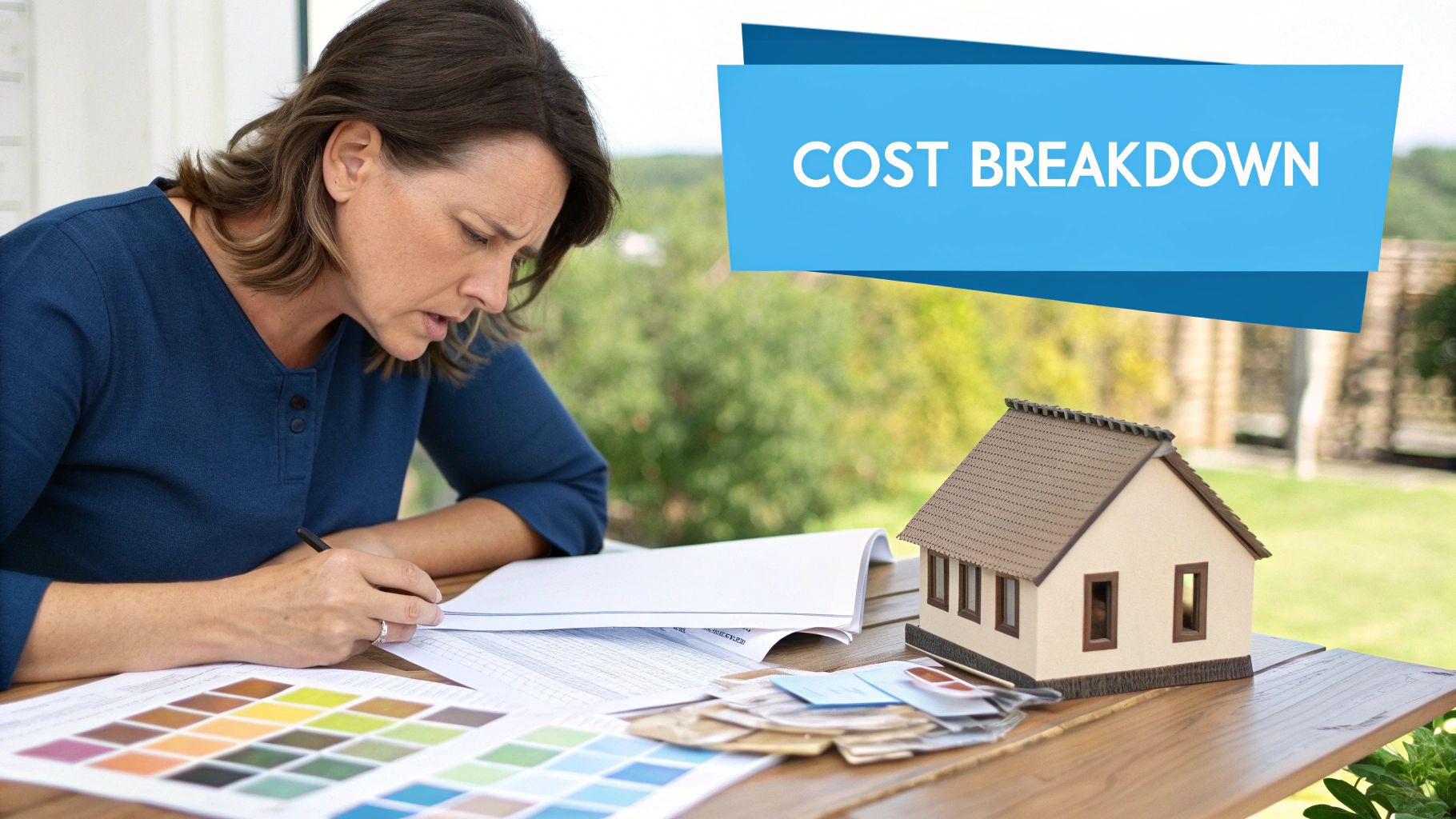
When most people think of board and batten, the modern farmhouse look immediately comes to mind. But its potential goes so much further than that. This siding is a seriously versatile tool for giving your home a distinct personality, especially when you move beyond just covering the entire exterior.
One of the most impactful ways we see it used is as a textural accent. Think about installing board and batten on just the gables or the upper-story dormers. This simple move creates a stunning visual contrast against the main siding, adding a layer of depth and character that feels intentional and custom.
Another trick from the pros is to mix your materials. Imagine pairing the clean, vertical lines of board and batten with the rugged, organic feel of stone or brick. The combination is just fantastic—it gives off a sophisticated, high-end vibe that’s especially popular in places like the Pacific Northwest, where it helps homes blend modern design with the natural landscape.
Playing with Proportions and Color
You can completely change your home's character just by tweaking the siding's proportions. Wider boards paired with slimmer battens create a bold, contemporary statement. On the other hand, keeping the widths more uniform leans into a classic, traditional aesthetic.
Don't forget about color, either. While white is classic, a dark charcoal or a deep navy can instantly transform board and batten from rustic to strikingly modern.
A great way to visualize this is to think of your house in separate sections. You could use traditional horizontal lap siding on the main body of the house, then switch to board and batten on a part that juts out, like the garage or entryway. It creates a dynamic, layered look that really pops.
And who says board and batten is just for the outside? Bringing it indoors for a feature wall in a living room, entryway, or bedroom can add incredible architectural interest and a touch of rustic elegance.
If you're looking for more ideas, check out our project gallery to see how some of these creative applications look in the real world.
A Few Common Questions About Board and Batten
Making a big decision like replacing your home's siding always comes with questions. It's a huge investment, so you want to get it right. Let's walk through some of the things homeowners ask us most often so you can feel confident in your choice.
Can You Put Board and Batten Over Existing Siding? What Does it Cost?
One of the first things people want to know is how the cost stacks up against other siding styles. Generally, board and batten is a bit more expensive than your standard horizontal lap siding. This is mostly because installing the battens is an extra step that requires more time and precision from the installation crew. The material you pick—whether it's vinyl, fiber cement, or wood—will ultimately be the biggest driver of your final price tag.
Then comes the big question: can you just install it over your old siding? While it might seem like a tempting shortcut, it's a huge no-no from any reputable professional.
Covering up old siding is like putting a bandage on a problem you can't see. It can trap moisture, hide underlying rot in your home's structure, and make it impossible to get the new siding perfectly flat and secure. This approach often voids material warranties and sets you up for much bigger, more expensive headaches down the road.
A professional siding replacement is an opportunity to fix underlying issues, not hide them. A reputable contractor will always remove the old siding to inspect the wall sheathing for damage, repair any rot, and install a new weather-resistant barrier before the new siding goes on. This ensures a durable, long-lasting result.
Is It a Good Choice for My Climate?
This is a fantastic question, and for homeowners here in the Pacific Northwest, the answer is a definite yes—as long as you choose the right material. The vertical lines of board and batten are brilliant at shedding rain, helping water run right off instead of collecting in horizontal seams.
Here’s a quick breakdown of what works best:
- For wet, rainy climates: You can't go wrong with fiber cement or vinyl. They are completely unfazed by moisture, so you'll never have to worry about rot or warping. They hold up beautifully through our long, damp seasons with very little upkeep.
- For areas with big temperature swings: If you live somewhere that gets hot summers and cold winters, engineered wood and fiber cement are excellent. They don't expand and contract much, so they remain stable and keep their good looks year-round.
When you pair this classic style with a modern, high-performance material, you get siding that’s not just beautiful but also incredibly durable for just about any environment.
Ready to transform your home with the timeless appeal of board and batten siding? The expert team at Breeze Siding is here to help you navigate every step, from material selection to flawless installation. Schedule your free, no-obligation estimate today.

